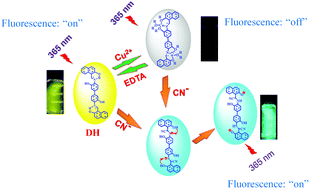A novel highly sensitive dual-channel chemical sensor for sequential recognition of Cu2+ and CN− in aqueous media and its bioimaging applications in living cells†
Abstract
A simple and unique dual-channel chemical probe (DH) was designed and synthesized, which not only realized sequential recognition of Cu2+ and CN− by colorimetric and fluorometric methods, but also realized fluorescence detection of CN−. When different cations (Co2+, Mg2+, Ni2+, Cd2+, Hg2+, Al3+, Ag+, Cu2+, Pb2+, Fe3+, Zn2+ and Ca2+) were added into the solution containing the probe molecule DH, only Cu2+ induced an observable change in the UV-vis and fluorescence spectra, indicating that the probe molecule can be applied for specific recognition of Cu2+. The anti-interference experiment of DH to Cu2+ showed that DH has good selectivity for detecting Cu2+, with a detection limit of 7.05 × 10−7 M. In particular, the fluorescence “ON–OFF–ON” process can be recycled by sequentially adding Cu2+ and EDTA, and the fluorescence intensity remained unchanged after ten times. This observation suggested that DH can achieve reversible highly sensitive response to Cu2+ and EDTA, and can be used as a hypersensitive logic gate for Cu2+ detection. More interestingly, when different anions (CH3COO−, SO32−, H2PO4−, ClO4−, NO3−, HSO4−, I−, Cl−, F−, Br−, N3− and CN−) were added into the solution containing DH and Cu2+, only CN− induced color change of the solution from red to yellowish green, and the fluorescence intensity greatly enhanced, indicating that DH-Cu2+ has a specific response to CN−. The anti-interference experiment showed that DH-Cu2+ has good selectivity for CN−, with a detection limit of 8.11 × 10−6 M. Moreover, the probe molecule DH can detect CN−, with a detection limit of 7.61 × 10−6 M. Experimental and theoretical methods were applied to deeply study the detection mechanism of DH, present great potential in practical application for ion test strips and HeLa cell imaging reagents.



 Please wait while we load your content...
Please wait while we load your content...